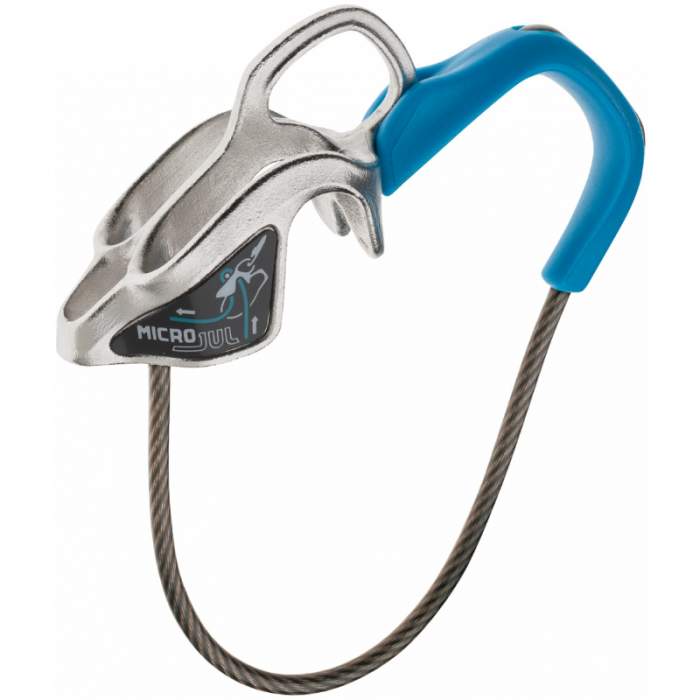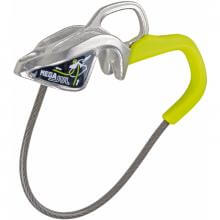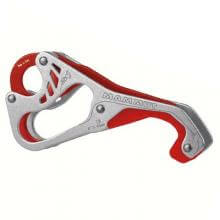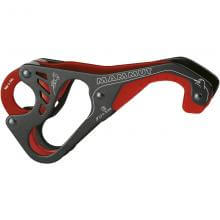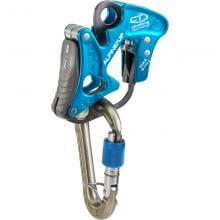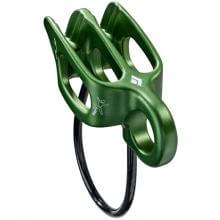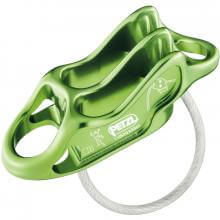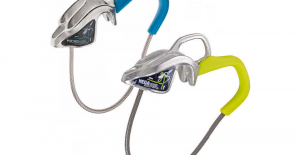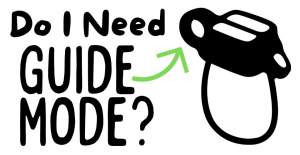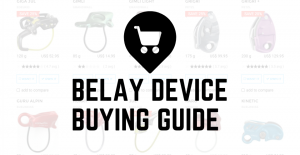How to use Mega Jul and Micro Jul, safety, lifespan, storage and care with instructional pictures.
Micro Jul
Description
A compact, ultra-light belay and abseil device for half ropes and twin ropes. The only suitable device for use with the Flycatcher 6.9 mm.
For belaying a leader or bringing up 2 seconds, also suitable for abseiling
Robust solid stainless steel construction
Very lightweight construction
High braking performance assists the belayer with leader falls
Small eyelet for releasing unit with a carabiner when bringing up your partner
Rope can be paid out faster to a leader by holding device in the “open” position with the thumb
Retail price
This Product is Hard to Find.
We don’t know where you can buy this item online in the US. We’ll continue to check all the major retailers and will update this page as soon as we find one.
If you know where to find this online in the US, let us know, and we’ll add the link.

Device Type  Device TypeTubeThe most commonly used belay type also called an “ATC” or “tuber.” Other than a distinction between other belay device types, “Tube” is a rarely used term, most climbers just assume you're talking about this style when they refer to your "belay device." 
Figure 8Mostly used in rescue, canyoneering, tactical, work safety, or by old school climbers and rappellers. One reason they went out of popularity with recreational climbers is because they tend to create twists in the rope. 
Brake AssistThese devices assist in stopping the rope when a climber falls or hangs on the rope. 
Often referred to as “auto-blocking” but that’s not the official terminology because no belay device should be assumed to work automatically by itself, even if it feels like it does (or does most the time). PlateWhen simplicity is a must, or you started climbing before Tubers were the norm. Bonus: They tend to be very light weight. 
DescenderFor rappelling, not for belaying a lead climber or top-roping. 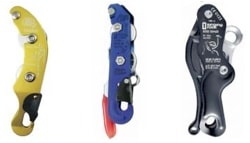 |
Brake Assist - Tube |
Weight (g)  Weight (g)In grams, the weight, as stated by the manufacturer/brand. |
62 g |
Belay Brake Assist  Belay Brake AssistThis is when the belay device significantly reduces the amount of holding power the belayer must exert to stop a fall and hold a climber. This is also called "assisted-braking" as the device must hold a significant amount of the climber’s weight; this term does not include friction-adding "teeth" found on some tube style belay devices. Confusingly referred to as “auto-blocking” or “auto-locking” these terms wrongly imply the device will always, automatically, stop a fall or hold a climber even if the belayer/rappeller is hands-free. These devices are not meant to be used without a hand on the braking side of the rope; the belayers/rapppeller brake hand should always be on the brake rope. Worth ConsideringMost of the mechanical brake assist devices only hold a single strand of rope and are not capable of double-strand rappelling (the most common method of rappel). |
Yes |
| Rope Options | 1 or 2 ropes |
Guide Mode  Guide ModeThis is when you belay directly off the anchor instead of your harness. Guide mode is helpful if you climb outdoors a lot because it reduces the holding power required from the belayer. When your partner falls or rests, the weight of the climber is held mostly by the anchor and the belay device. Tubers and PlatesWhen belaying in "guide mode," the tubers and plates turn auto-blocking. During a fall, the climbing rope pinches the slack rope, completely stopping the movement of either rope. A common guide mode setup shown below. 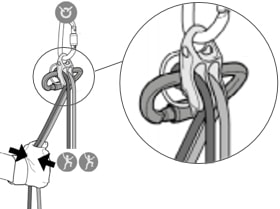
Mechanical Brake Assist DevicesThere is no difference in the functionality of the device. A brake-hand should always be on the rope to ensure the climber is caught in the case of a fall. A common guide mode setup shown below. 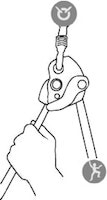
Where guide mode is used
Learn Morehttp://www.climbing.com/skill/essential-skills-auto-blocking-belay-devices/ |
Up to 2 followers |
Teeth  TeethTeeth are only seen on tube devices. They add friction that helps grip the rope for more belaying control. This is helpful for belaying heavier climbers. Teeth are becoming standard on new tube devices. 
Worth ConsideringTeeth do wear out. You can limit wear by rappelling on the side without teeth (if you don’t need the extra friction). Once they’re worn, you’ll still have a usable belay device, just less friction. |
No |
Rope Range (mm)  Rope Range (mm)The range of rope diameters, in millimeters, that the manufacturer/brand specifies can safely be used. This is the best case scenario and does not necessarily take into consideration that certified ropes have a tolerance of +/- .3 mm. Recently, manufacturers have started to add an "optimized" rope range -- this is the range that will result in the nicest handling of the belay device. | 6.9 mm
- 8.9 mm
single 8.0 - 8.9 mm, double 7.9 - 8.9 mm, twin 6.9 - 8.0 mm |
Certification  CertificationsThe main climbing gear certifications are CE and UIAA--and normally the UIAA creates the rules that the CE body also supports. When possible, we try to list all the certifications the product carries. To sell a climbing product in Europe, the device must be CE certified. There are no official requirements to sell climbing gear in the US. The UIAA certification is a voluntary process. Learn MoreRock and Ice Certifications Guide |
|
Previously this device had different rope ranges listed (and you'll hear different rope ranges on Edelrid's and WeighMyRack's videos about this product). The rope ranges written previously were safe to use, but these more recent numbers will ensure better handling.
No reviews yet.
The Micro Jul was designed to accompany their groundbreaking Flycatcher rope, the thinnest half rope on the market at 6.9mm. The problem was the Flycatcher was so skinny there wasn’t a single belay device rated to handle a rope that thin. After designing the Micro Jul specifically for skinny ropes, they realized that the belay device had so many helpful features it was worth making another one that could handle “standard” rope diameters. Thus, the Mega Jul was born, identical in functionality to the Micro Jul, differing only in what rope diameters it is designed to handle [Micro Jul: 6.9mm-8.5mm Mega Jul: 7.8mm-10.5mm].
So, given my views regarding the Alpine Up’s performance, It would seem as though it would replace my other belay devices. However, even though it’s the best performer, there are times when I still prefer the Edelrid Mega Jul or Micro Jul.
The Mega Jul and Micro Jul are significantly lighter and more compact, so when weight and space are at a premium (i.e. alpine climbing) I will usually reach for one of the Edelrid devices over the Alpine Up. Also, the Micro Jul is the only device capable of being used with really skinny twin ropes, such as the 6.9mm Edelrid Flycatcher.
Bottom line is that when I’m cragging, I generally take the Alpine Up. When I’m alpine climbing, I generally take the Mega Jul or Micro Jul.
This video shows Daniel Gebel explaining all the features of Mega Jul and Micro Jul belay device.
Video shows how it works.
This video shows detail instruction of using Micro Jul and Mega Jul
How to use Mega Jul and Micro Jul, safety, lifespan, storage and care with instructional pictures.

